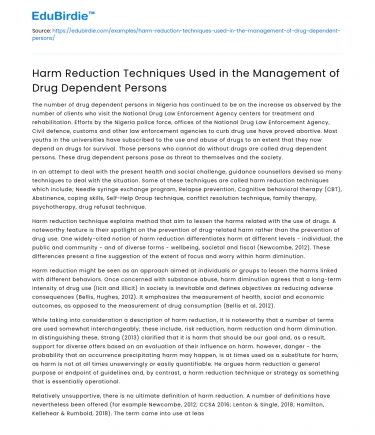Introduction
The management of drug dependence has evolved from punitive measures to more compassionate approaches, with harm reduction techniques taking center stage. Harm reduction is a pragmatic set of strategies aimed at minimizing the negative health, social, and legal impacts associated with drug use, without necessarily requiring cessation. This approach recognizes the complex nature of addiction, encompassing biological, psychological, and social dimensions. As an evidence-based practice, harm reduction acknowledges that while abstinence may be ideal, it is not always feasible, thus prioritizing the improvement of individuals' health and well-being. Through programs like needle exchange, supervised consumption sites, and opioid substitution therapies, harm reduction strategies have shown promising results. This essay explores these techniques, examining their effectiveness and addressing criticisms to provide a comprehensive understanding of their role in managing drug dependency.
Needle Exchange Programs: A Preventative Measure
Needle exchange programs (NEPs) are a cornerstone of harm reduction strategies, aimed at preventing the spread of infectious diseases among intravenous drug users. These programs provide clean syringes in exchange for used ones, significantly reducing the transmission of HIV, hepatitis C, and other blood-borne pathogens. A study published in the Journal of Acquired Immune Deficiency Syndromes noted that cities with NEPs experienced a 30% reduction in HIV rates among drug users compared to those without such programs. By offering a safe way to dispose of needles, NEPs also mitigate the risk of injury and infection to the broader community.
Save your time!
We can take care of your essay
- Proper editing and formatting
- Free revision, title page, and bibliography
- Flexible prices and money-back guarantee
Despite their proven efficacy, NEPs face criticism from those who argue they encourage drug use. However, evidence suggests otherwise. According to the World Health Organization, NEPs do not increase drug consumption; instead, they serve as a crucial entry point for addicts to access further health services, including detoxification and rehabilitation. This multifaceted role underscores NEPs' importance in harm reduction, offering a pragmatic solution to a complex issue while addressing public health concerns.
Supervised Consumption Sites: A Safe Haven
Supervised consumption sites (SCSs) provide a controlled environment where individuals can use drugs under medical supervision. These facilities aim to reduce overdose deaths, promote safer injection practices, and connect users with treatment services. Insite, North America’s first legal SCS located in Vancouver, Canada, has become a model of success. Since its inception in 2003, Insite has managed over 3.6 million visits, with zero overdose fatalities reported on its premises. The presence of trained staff allows for immediate intervention in case of overdose, significantly reducing mortality rates.
Critics of SCSs argue they normalize drug use and attract criminal activity. However, research indicates these sites do not lead to increased drug use or crime in surrounding areas. A study in The Lancet found that SCSs were associated with a 35% reduction in overdose deaths within their vicinity. Furthermore, they provide a critical point of contact for marginalized populations, fostering trust and facilitating access to healthcare, housing, and social services. Thus, SCSs not only save lives but also act as a bridge to recovery and reintegration into society.
Opioid Substitution Therapy: A Path to Stability
Opioid substitution therapy (OST) involves replacing illicit opioids with prescribed alternatives, such as methadone or buprenorphine, under medical supervision. This treatment aims to stabilize individuals, reduce cravings, and diminish the harmful effects of illicit opioid use. The success of OST is well-documented; for instance, a report by the National Institute on Drug Abuse indicates that methadone maintenance treatment reduces heroin use and related criminal activity by more than 50%.
While OST has proven effective, it is not without its detractors. Some argue that it merely substitutes one addiction for another. However, the controlled nature of OST allows for gradual dosage reduction, facilitating eventual abstinence. Moreover, OST enhances quality of life by enabling individuals to engage in productive activities, such as employment and education, thus supporting their long-term recovery journey. By focusing on stabilization and harm reduction, OST provides a realistic and compassionate approach to managing opioid dependence.
Conclusion
Harm reduction techniques represent a paradigm shift in the management of drug dependency, prioritizing the health and dignity of individuals over punitive measures. Through needle exchange programs, supervised consumption sites, and opioid substitution therapy, these strategies have demonstrated their capacity to reduce harm and facilitate recovery. Although met with criticism, the evidence supports their effectiveness in improving public health outcomes and offering pathways to rehabilitation. As the understanding of addiction evolves, harm reduction continues to play a pivotal role in shaping compassionate and effective drug policies. By embracing these strategies, society can better support drug-dependent individuals in their journey towards health and stability.






 Stuck on your essay?
Stuck on your essay?

